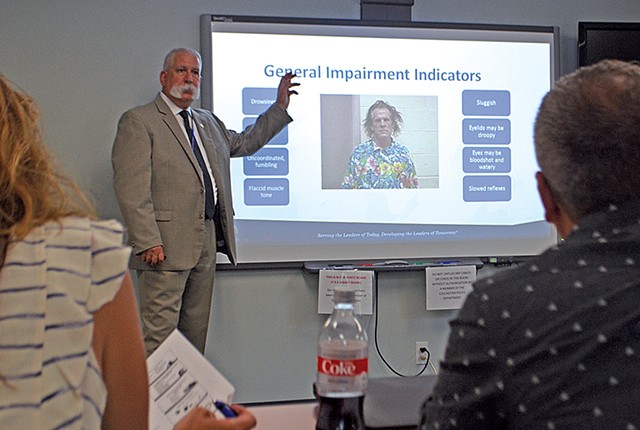
- Sasha Goldstein
- Detective Sgt. James Roy
Detective Sgt. James Roy of the Colchester Police Department held up a black flip-flop sandal so his audience could see it.
Then, like a magician performing a trick, he took a small Allen wrench-like tool, stuck it into the sandal's side and turned. With a small paper cup in his other hand, Roy tipped the footwear and poured out clear liquid — in this case, water.
The heel of the Reef brand shoe doubles as a flask.
"You could have a student standing on eight ounces of alcohol, and you'd never know the difference," Roy told the five school administrators seated before him, some of whom shook their heads in disbelief as if he'd just sawed a volunteer in half. "Those cost me $23 on Amazon."
Since 1989, Roy has studied intoxicants and how they affect the human body. The stout 57-year-old cop with a walrus mustache and close-cropped white hair is one of about 50 law enforcement drug-recognition experts in Vermont. Police summon DREs when they suspect a driver is under the influence of something other than alcohol.
On this day in early August, though, Roy was sharing his knowledge with Colchester educators — something he's done with approximately 3,000 teachers, administrators and nurses across Vermont — in anticipation of the new school year. He had transformed a space at the Colchester Police Department into a classroom in which the "pupils" were high school principal Heather Baron; assistant principals Erica LeClair and Chad DeMagistris; director of student support services Jean Shea; and Julie Tanguay, director of student support services at the middle school.
A major emphasis of the two-day training, Roy told his neophytes, was learning how to assess a young person for signs of drug use — in school or out.
"It's difficult," the veteran cop admitted. "It's like watching your own child grow ... We see them every day, and we're not picking up on those subtle changes. But with some clear focus and with some attention paid to that, you can." Educators should be careful not to miss an opportunity to intervene, he said.
The attendees took notes as Roy delivered a mix of science and health information interspersed with history lessons and war stories from life on the beat. He reminded the group that one of the Colchester Police Department's own — former officer Tyler Kinney — stole heroin from the police evidence room and used it for months. None of his colleagues noticed.
Easier to detect? Roy showed a mug shot of a drunk and disheveled Nick Nolte in a colorful Hawaiian shirt that went viral when the actor was busted for DUI in 2002. Another projected image showed a guy smiling, with silver paint all over his face, after being arrested for huffing spray paint for the 48th time.
Throughout the day, Roy described different drugs, their effects on the body and mind, and recognizable signs that someone is intoxicated. A person with pinpoint-sized pupils might be on heroin, he said, while an elevated pulse rate could indicate cocaine use.
"How many of you pay attention to pupil size — anybody?" Roy asked.
No one raised a hand.
"That's like the No. 1 fact finder," Roy said. Referencing the old adage about eyes being the "windows to the soul," he said, "I have no clue about that, but it is a direct pathway to the central nervous system."
He described the different drug categories: central nervous system depressants, such as Ambien and alcohol; stimulants, such as cocaine and Adderall; hallucinogens, such as LSD and magic mushrooms; and dissociative anesthetics, such as ketamine and dextromethorphan, aka DXM, a drug found in cough medicines.
"I've seen thousands of folks under the influence of drugs," Roy said. "I have never seen anybody more messed up, more profoundly impaired, than an 18-year-old girl from Winooski who had taken DXM."
One administrator chimed in, "That was a big thing when I was in college. People would drink Robitussin."
Roy confirmed that students still "Robotrip," but they've gotten savvier: Some websites provide tutorials on how to extract the psychoactive material, making it more dangerous — and easier — to get high.
"Kids are certainly aware that these websites exist," Roy said. "We have to pay attention to what's going on out there. We can't have our heads buried in the sand."
And it's not just obscure websites in dark corners of the internet, he noted. Roy displayed an Axe body spray advertisement that showed an open refrigerator filled with cans of whipped cream. Outside the fridge, a single can of Axe promised "The new, longer lasting Axe effect." Such aerosol containers use nitrous oxide to expel their contents, and teens have long huffed the stuff to get stoned.
"Oh, my God, that's an Axe ad?" one administrator asked, aghast.
Roy nodded. "You all drew from it that that one can would get you as high as maybe all of those cans, in terms of nitrous oxide," he said of the ad's not-so-subtle message.
It appeared in a national video game magazine, Roy noted, while the company simultaneously distributed free samples of Axe to schools.
"A lot of this stuff doesn't happen by accident," Roy told the class. "There are lots of undercurrents and influence going on that we as adults sometimes don't pay any attention to."
Similarly, cannabis businesses in states with legal weed sales appear to market gummy bear edibles and laced chocolates with names like Buddhafinger and 3 Rastateers to young people. Marijuana is now legal in Vermont for adults 21 and older, and Roy suggested it's only a matter of time before such products show up in the Green Mountain State, though retail remains off-limits for now.
Roy described research that shows cannabis can have detrimental effects on the still-developing brains of teens. And pot today is much more potent than it was decades ago, he added. He showed images of a commercial grow operation he visited in Colorado, which legalized recreational cannabis in 2012.
"These are incredibly genetically engineered plants, given the best opportunity to grow with folks who have PhDs in growing stuff," he said. "It's amazing what they're producing."
During a break, principal Baron said legal weed wasn't the impetus for taking the course. She and her administrative team all started their jobs in Colchester within the last three years, and they decided that "it would be really smart for us to have the training all at once together."
"I just think it's a reality that kids are engaging in drinking and doing drugs," Baron continued, echoing what high school principals have known since the '60s. "And the more we can be on top of it with them — the better educated we can be — we can better help them navigate that world."
If Roy is right, it's a world filled with dangers and dumb decisions. He recounted the tale of a young man on an acid trip who jumped naked from a friend's car and ran into Lake Champlain. Police found him clinging to a boat docked in Malletts Bay. And the story of the male and female students at one Vermont school who would soak tampons in vodka "and insert them into their bodies and get alcohol into their system that way."
He also cautioned educators that odd behaviors aren't all drug-related. For instance, a student with a head injury could have different size pupils. In 2002, Vermont police chased Rodney Mayo as he drove the wrong way on Interstate 89. He was in diabetic shock and didn't know what he was doing.
"Take everything into account and interpret everything properly, but don't focus on just one piece," Roy said.
Near the end of day one, the administrators and Roy discussed best practices for speaking with students suspected of drug use and how to deal with their reactions.
Knowledge would support the adults' authority, Roy advised.
"If you are engaged, you know what you're talking about and you're able to talk with that person about what's going on, they'll more likely than not be honest with you," Roy said. Presented with evidence, "It's easier for them to say, 'Yeeaah, I think you got me.'"
Baron agreed. "We come from a place of care," she said, as if addressing the students directly. "There will be consequences, but we're here to help you."












Comments
Showing 1-1 of 1
Comments are closed.
From 2014-2020, Seven Days allowed readers to comment on all stories posted on our website. While we've appreciated the suggestions and insights, right now Seven Days is prioritizing our core mission — producing high-quality, responsible local journalism — over moderating online debates between readers.
To criticize, correct or praise our reporting, please send us a letter to the editor or send us a tip. We’ll check it out and report the results.
Online comments may return when we have better tech tools for managing them. Thanks for reading.